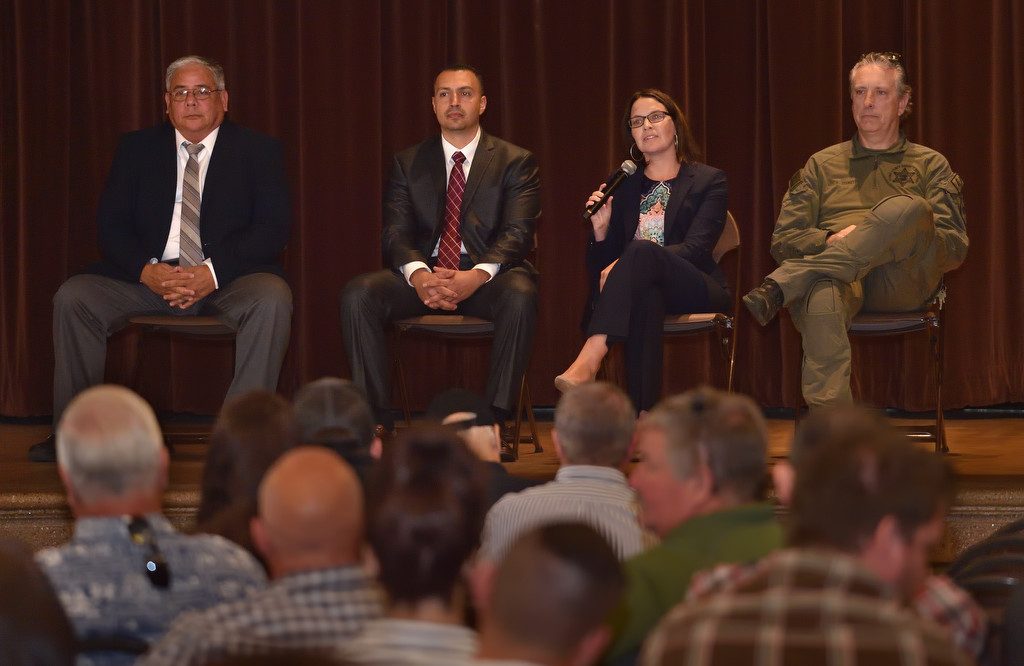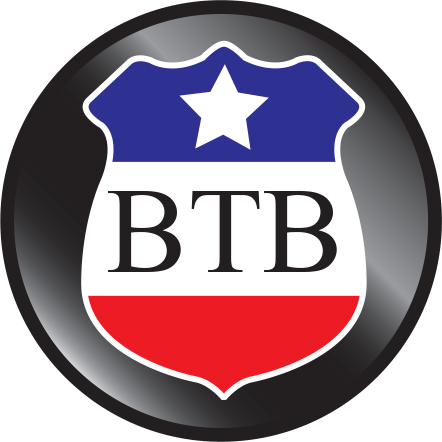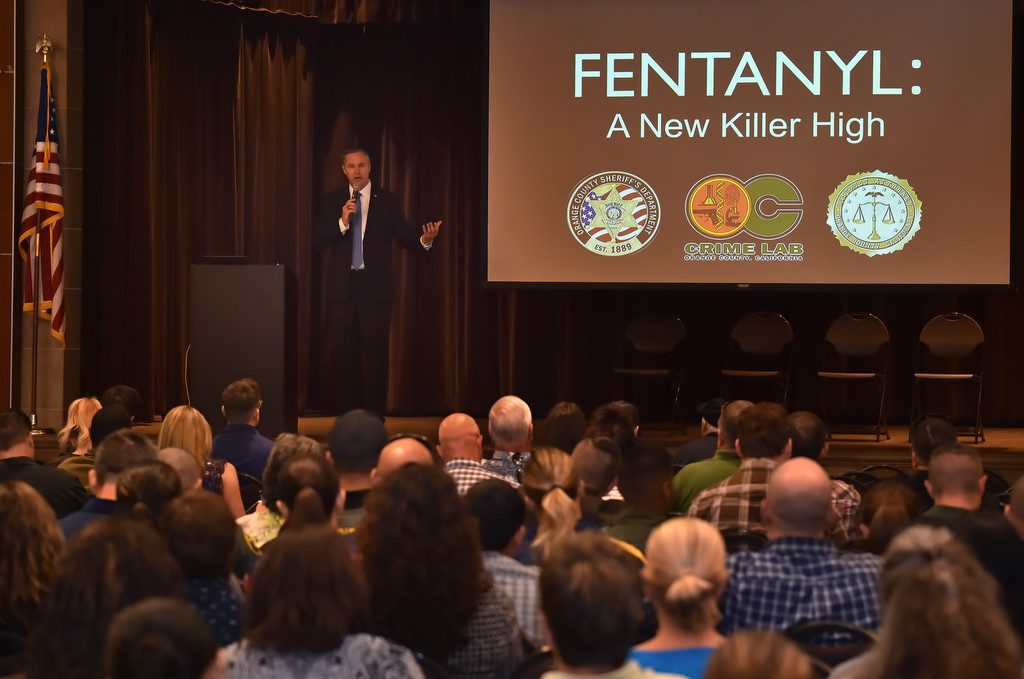An Ohio police officer in May overdosed on the synthetic opioid fentanyl after getting the deadly drug on his uniform during a traffic stop.
In August, 18 Pittsburgh police officers, all SWAT members, were sickened and taken to the hospital after being exposed to fentanyl during a drug raid.
Such incidents have prompted the U.S. Drug Enforcement Administration to issue warnings to law enforcement nationwide about the potential deadly consequence of handling fentanyl.
Locally, the Orange County Sheriff’s Department (OCSD) is doing the same.
The OCSD recently gathered a of group law enforcement experts at the Laguna Hills Community Center to discuss the dangers of coming in contact fentanyl.

David Pena, center, listens with his fellow deputies as they attend a training seminar on fentanyl for law enforcement officers and medical professionals. Photo by Steven Georges/Behind the Badge OC
Held at the Laguna Hills Community Center, the event was titled “Fentanyl: The New Killer High.”
The audience included 200 or so first responders along with anyone who may come in contact with fentanyl
Speakers included an OCSD narcotics investigator, OC Crime Lab expert and a sergeant with OCSD’s Hazardous Device Unit.
Each described their experiences with fentanyl-related cases.
According to a recent Washington Post investigation, the numbers of fatal overdoses related to the drug jumped to 3,964 in 2016 – up from 582 two years earlier.
Fentanyl is 50 to 100 times more potent than heroin, as well as more affordable, OCSD Undersheriff Don Barnes said to the audience.
Just two grains can be deadly.
The OCSD began dealing with fentanyl about three years ago and use of the drug has increased exponentially ever since, Barnes said.
“If you think this isn’t happening here, that affluent Orange County is not experiencing this problem, I can show you the statistics and can tell you that you are very, very wrong,” the undersheriff said. “Very affluent neighborhoods, economically challenged neighborhoods … it doesn’t matter who it’s targeting. Everybody is affected the same way. It poses significant public safety risks.”
Fentanyl is so potent, Barnes said, that even a non-user who just happens to be near the drug is at risk.

Orange County Undersheriff Don Barnes welcomes everyone attending a training seminar on fentanyl at the Laguna Hills Community Center. Photo by Steven Georges/Behind the Badge OC
“They can accidentally dose themselves,” the undersheriff said. “It can flatline you. It can kill you.”
As of the Oct. 13 workshop, Orange County has seen 25 fentanyl related deaths, said Jennifer Harmon, assistant director of the OC Crime Lab.
The figure is nearly equal to the number deaths connected to the drug in all of 2016.
“And there are still three months to go,” Harmon said.

Jennifer Harmon of the Orange County Crime Lab talks about the evolution of the opioid epidemic, what fentanyl is and future projections during a training seminar hosted by the Orange County Sheriff’s Department. Photo by Steven Georges/Behind the Badge OC
Harmon implored anyone who could be exposed to fentanyl to take every precaution.
Wearing protection, long-sleeve shirts, two pairs of gloves and respiratory masks will mitigate exposure, Harmon said.
“It can look like coke, or heroin or regular pills,” she said. “You have no idea whether it is going to be fentanyl or not.”
Police officers should put drug evidence in a Ziploc, heat-sealed bag and consider double bagging the evidence, Harmon said.
“It is a different day in terms of narcotics,” Harmon said. “I’ve got drug chemists who have been doing this for a couple of decades who will tell you that they never expected what we are dealing with. You have to consider there is going to be a potential threat every time you are working with narcotics.”
Ash Abdelmuti, an investigator with the OCSD Regional Narcotics Suppression Program and an 18-year law enforcement veteran, said fentanyl is often mixed with other drugs, such as cocaine, heroin and oxycodone by the time it makes it way to the user.

Inv. Ash Abdelmuti of the Regional Narcotics Suppression Program talks about the dangers of fentanyl during a training seminar. Photo by Steven Georges/Behind the Badge OC
Even the most hardened addicts, who may have built up a tolerance to other opiates, are susceptible to overdosing, he said.
“If you buy heroin and you’ve been slamming heroin for past 20 years, and you’re really buying heroin that contains fentanyl, you are really buying a deadly dose,” Abdelmuti said. “You see people dropping dead. It’s real. We see it in our neighborhoods. We see it in areas we patrol. We are seizing it. It is happening all the time.”
If fentanyl is so deadly, why has it become so popular?
“It’s all about money,” Abdelmuti said. “Money is the number one motivator for these drugs. That is why fentanyl is here, because fentanyl is a lot cheaper. You can make as much as you want. That is why we are seeing it and we are going to continue to see it. It’s going to come and it is going to keep coming.”
According to Project Know, signs of abuse include:
- Feelings of euphoria and relaxation
- False sense of well-being
- Confusion
- Sedation
- Drowsiness
- Dizziness/lightheadedness
- Nausea and vomiting
- Drug-seeking behavior (doctor shopping, forging prescriptions)
- Drug tolerance (needing more to achieve same effects)
- Constipation
- Respiratory depression or arrest
- Withdrawal symptoms

OC District Attorney’s Office Deputy DA Ben Masangkay talks about prosecution and preparing yourself for being a witness in court during a training seminar on fentanyl for law enforcement officers and medical professionals. Photo by Steven Georges/Behind the Badge OC

OC District Attorney’s Office Deputy DA. Ben Masangkay, left, Inv. Ash Abdelmuti of the Regional Narcotics Suppression Program, Jennifer Harmon of the Orange County Crime Lab, and Sgt. Randall Sterett of the OCSD Hazardous Device Unit take takes questions during a panel discussion on fentanyl at the Laguna Hills Community Center. Photo by Steven Georges/Behind the Badge OC
 Behind the Badge
Behind the Badge




